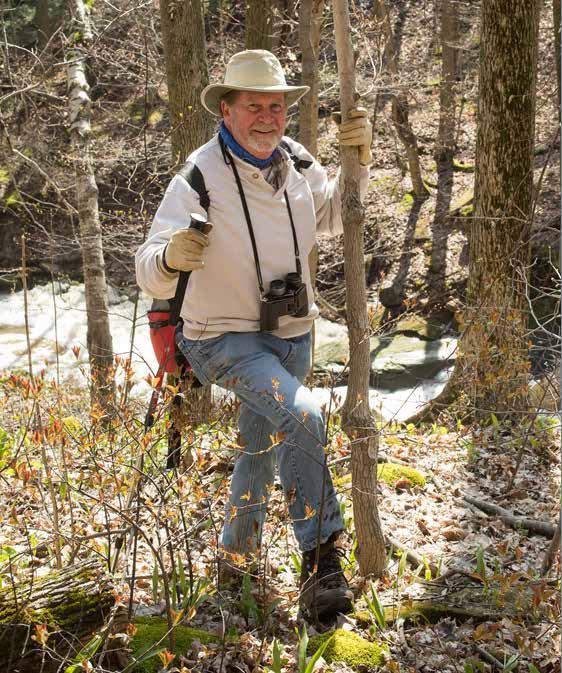
7 minute read
Bruce Mackenzie
Bruce Mackenzie in the Beamer Falls Gorge, Grimsby. Photo by Mark Zelinski
Bruce Mackenzie’s environmental work is a labour of love. The Grimsby Citizen of the Year is a well-known naturalist who just recently became the Grimsby representative to the Niagara Peninsula Conservation Authority (NPCA). From his long-time career in the Hamilton Conservation Authority, where he held numerous roles while fostering 11,000 acres of natural lands, to his tireless volunteer efforts to restore the decommissioned Biggar Lagoons, Bruce is proud of the work he has been involved in… and he isn’t slowing down. Congratulations on being appointed as the Grimsby Representative to the Niagara Peninsula Conservation Authority (NPCA). What does this role involve and why did you take it on? Primarily this position is to act as a member of the Board of Director’s of the NPCA. I believe in giving back and do what ever I can to inspire people to have the same considerations for nature as I do. After having spent my entire career with the Hamilton Conservation Authority as a Manager of Conservation Lands / Customer Services and with being a very active naturalist I felt that I would be able to contribute well to the workings of the new Board of the NPCA. I believe public agency boards should have a strong citizen component. After having received the first Rt. Hon. John Turner Water and Environmental Leadership Award in 2016 from the Niagara Peninsula Conservation Foundation my interests in the NPCA began. You have worked hard to combat invasive species. Tell us about that and what strides have you made to get ahead of this issue? I have been involved with the negative effects of invasive species, be they diseases, insects, plants, aquatic invertebrates, and fish throughout my career. Zebra mussels have changed many of our waterways. Garlic Mustard and European Buckthorn are having profound effects on our forests and regeneration of native plants. I have seen the native wildflowers disappear from some areas because of these plants. We have lost the Sweet Chestnut Tree, most White Elms and now are seeing Ash trees decimated to various introduced pests. At the Grimsby Wetlands we carried out a major control project on the non-native invasive Phragmites Grass. This plant, from the Middle East, is considered to be the most significant threat to wetlands in eastern North America. Working with consultants and an experienced contractor a successful control project was carried out in Grimsby. It was guided by the Hamilton Naturalists’ Club, HNC, and the NPCA and funded by the HNC.
Your passion for the natural world is evident. When did your love of nature start? From the beginning, I think. I have always had a curiosity about natural history and my family always encouraged me. I was fortunate to grow up near natural areas where I could explore and ask what and why. I have been so fortunate to be accompanied along my paths by my wife Laurie and rewarded in seeing my children inherit a curiosity and desire to give back. Moving from Toronto to Hamilton in 1976 and working in the Dundas Valley Conservation Area put me into the magic of the Niagara Escarpment biome.
You had a long career with the Hamilton Conservation Authority, including posts as the superintendent at the Fifty Point Conservation Area marina, and Director of Customer Service and Operations for the authority. Talk to us about those years and what you take away from those experiences? Almost all of my roles were new positions to the Conservation Authority. They really did not come with a manual. This provided
me with wonderful opportunities and wow, 11,000 acres of natural lands to foster. These lands came with close to 2 million visitor experiences every year. Balancing all of this was exciting. I learned early to anticipate and meet a customer’s expectations and if I tried to do one thing it was to instill in staff the need to care about the customer’s needs. Experiencing the natural lands and managing them was a privilege. The natural areas around Hamilton/Niagara are world class. The Niagara Escarpment, the Great Lakes, our microclimate and our heritage add up to incredible sums. Our job is to allow them to pass to the next generations unharmed. They cannot be replaced, ever.
What are some of the more unique species found in Grimsby and the greater Niagara community? Grimsby’s waterfront is part of the Western Lake Ontario International Important Bird Area. Each winter there are thousands of ducks on the local Lake Ontario waters and most are close to shore for all to enjoy. Watching and listening to thousands of Long-tailed Ducks on a winter’s day is a surreal experience. Nature is constantly changing. Today we are seeing new species move into the area. Fish Crows from the Atlantic Seaboard are showing up now with Black Vultures from

Wetlands at the former Biggar Lagoons, now called the Grimsby Wetlands. Photo by Drone’s Eye Photography

the south and Ravens and Merlins from the north are now a common site in the area and nesting successfully. These are exciting additions to our biota but we are concerned of course with today’s rarity of Upland Sandpipers, Bobolinks and American Kestrels and many other species. In Niagara we have Red Hickory, Tulip Trees, Black Gum and Cucumber Magnolia Trees. These are just some of the rare Carolinian tree species found in our forests. But it is all of the species that live with them that make up our endangered spaces. At the Grimsby Wetlands, a restored former sewage lagoon, we have seen the successful breeding of Soras, Virginia Rails and Common Gallinule, all quite rare regional nesting marsh birds. These are just some of the rewards we can reap from our restoration efforts. But the important work for us is to PROTECT our established natural areas. We have lost so many. We can’t build habitats for Jefferson Salamanders, Hooded Warblers and Pileated Woodpeckers. Only nature can. ■

Bruce on one of his nature hikes. Photo HNC.
Spotted Sandpiper, a breeding shorebird at the Grimsby Wetlands. Photo by Barry Cherriere

Until Spring 2020 Grimsby Museum presents “What’s in Your Bedroom” Exhibit grimsby.ca/Museum
March 7 Paper Bag Princess: 40th Anniversary Party grimsby.ca/library
Every Thursday until June 25 Play Chess grimsby.ca/library
March 7 Steven Rutledge Firehall Studio Concert stationonecoffeehouse.ca
March 17-21 March Break Events @ Grimsby Library grimsby.ca/library

March 18 GHS Guest Lecture Series – Liz Benneian grimsbyhistoricalsociety.com
March 20 March Break: The Angry Birds Movie 2 grimsby.ca/library
March 28 Grimsby Art Gallery Fundraiser “All You Need Is Love” 60 years of the Beatles grimsby.ca/Art-Gallery
March 28 Lincoln Mom to Mom Spring Sale momtomomsalelincoln.webs.com
March 29 LUNN Variety Show @ The Forty Public House stationonecoffeehouse.ca
March 30 Electronic Music Workshop grimsby.ca/library
March 31 Grimsby Author Series: Spring 2020 grimsby.ca
March 31 Red Stone Trivia Night: Harry Potter redstonewines.ca
Lucky Charm Meet

GIVE A LOVING ANIMAL A NEW LEASE ON LIFE.

SEX: FEMALE BREED: RETRIEVER / HUSKY AGE: 1 YEAR OLD ID#: 43100367
LUCKY CHARM IS THE LIFE OF THE PARTY. SHE IS SUPER ACTIVE AND HAS NO OFF BUTTON.
Her new adopters need to be committed to training her because she needs some obedience. This girl currently has no manners and is jumpy and mouthy when she gets excited. Once she is comfortable, she truly is so lovely! Lucky Charm’s perfect home has a fenced yard, no children under 14 years old and no cats.
Once she has some structure, she’ll be a wonderful dog!
All adoptable dogs have been given a behavioural test and our staff will be happy to explain the testing and discuss the results with potential adopters during the initial meeting with the dog you are interested in. To schedule a meeting with Lucky Charm, please contact the shelter: 905 682 0767 or myconnect@lchs.ca
To meet any of the other adoptable pets, please visit our shelter.
Mon to Fri - 9:00 am to 5:00 pm Saturday - 10:00 am to 4:00 pm Sunday - 11:00 am to 3:00 pm






